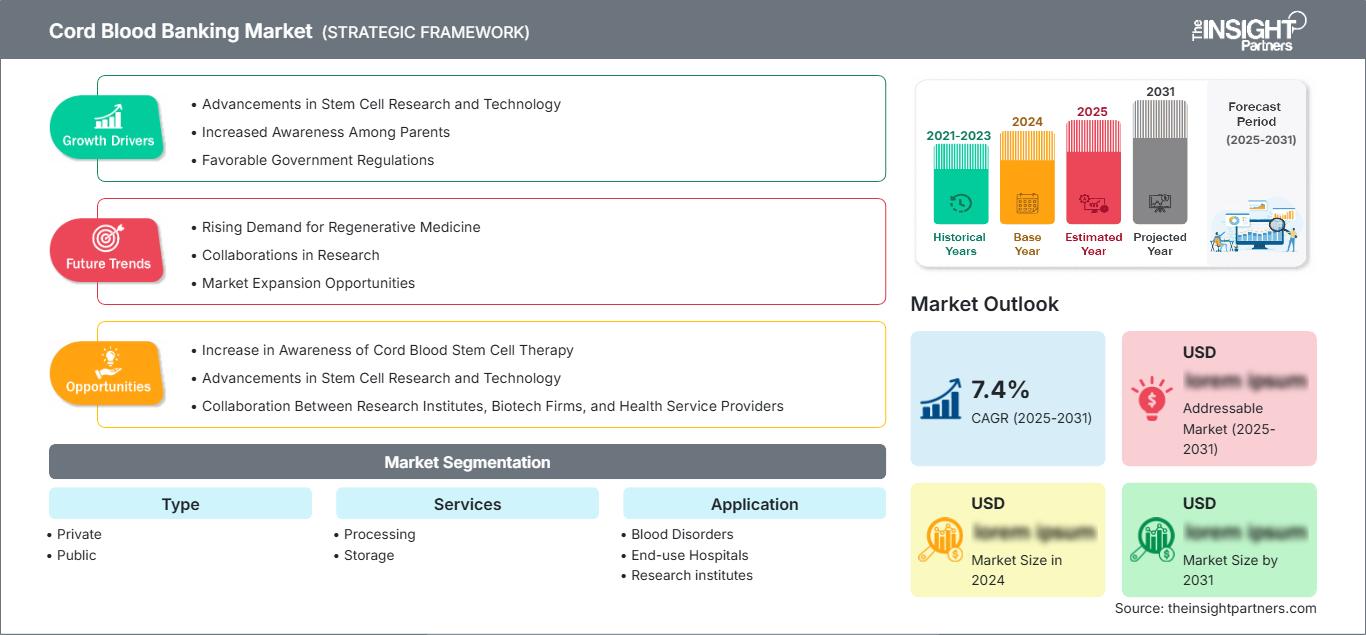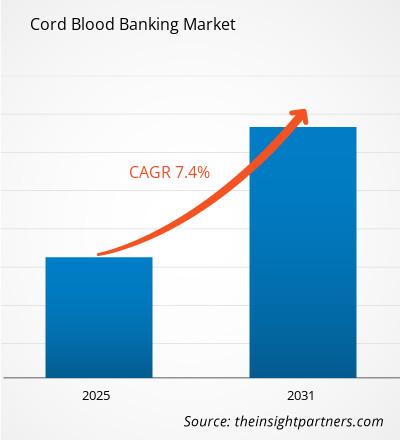Se espera que el mercado bancario de sangre del cordón umbilical registre una CAGR del 7,4 % entre 2025 y 2031, con un tamaño de mercado que se expandirá de US$ XX millones en 2024 a US$ XX millones en 2031.
El informe de investigación de mercado sobre bancos de sangre del cordón umbilical se divide por tipo en los siguientes subsegmentos: privado y público. El informe también ofrece un análisis basado en servicios, como procesamiento y almacenamiento. El mercado se segmenta por aplicación, como trastornos sanguíneos y hospitales de uso final. El informe también incluye un desglose regional. La evaluación del mercado se presenta en dólares estadounidenses para el análisis segmentario mencionado.
Propósito del Informe
El informe "Mercado de Banca de Sangre del Cordón Umbilical" de The Insight Partners busca describir el panorama actual y el crecimiento futuro, los principales factores impulsores, los desafíos y las oportunidades. Esto proporcionará información a diversas partes interesadas del negocio, como:
- Proveedores/fabricantes de tecnología: Para comprender la dinámica cambiante del mercado y conocer las oportunidades potenciales de crecimiento, lo que les permitirá tomar decisiones estratégicas informadas.
- Inversores: Realizar un análisis exhaustivo de tendencias respecto a la tasa de crecimiento del mercado, las proyecciones financieras del mercado y las oportunidades que existen en toda la cadena de valor.
- Órganos reguladores: Regular las políticas y las actividades policiales en el mercado con el objetivo de minimizar el abuso, preservar la confianza de los inversores y defender la integridad y estabilidad del mercado.
Segmentación del mercado de bancos de sangre del cordón umbilical
Tipo
- Privado
- Público
Servicios
- Tratamiento
- Almacenamiento
Solicitud
- Trastornos de la sangre
- Hospitales de uso final
- Institutos de investigación
Geografía
- América del norte
- Europa
- Asia-Pacífico
- América del Sur y Central
- Oriente Medio y África
Obtendrá personalización en cualquier informe, sin cargo, incluidas partes de este informe o análisis a nivel de país, paquete de datos de Excel, así como también grandes ofertas y descuentos para empresas emergentes y universidades.
Mercado de bancos de sangre del cordón umbilical: Perspectivas estratégicas

-
Obtenga las principales tendencias clave del mercado de este informe.Esta muestra GRATUITA incluirá análisis de datos, desde tendencias del mercado hasta estimaciones y pronósticos.
Factores que impulsan el crecimiento del mercado de bancos de sangre del cordón umbilical
- Avances en la investigación y la tecnología de células madre: las innovaciones en la investigación y la tecnología de células madre han liberado el potencial de las células madre de la sangre del cordón umbilical, aumentando significativamente el interés en los bancos de sangre del cordón umbilical.
- Mayor conciencia entre los padres: la creciente conciencia entre los padres sobre los beneficios médicos de almacenar sangre del cordón umbilical está contribuyendo al aumento de la recolección y el almacenamiento de sangre del cordón umbilical.
- Regulaciones gubernamentales favorables: Las regulaciones y políticas gubernamentales de apoyo están fomentando el crecimiento del mercado de bancos de sangre del cordón umbilical.
Tendencias futuras del mercado de bancos de sangre del cordón umbilical
- Creciente demanda de medicina regenerativa: la creciente prevalencia de enfermedades crónicas y el envejecimiento de la población impulsarán la demanda de terapias de medicina regenerativa, incluidas aquellas derivadas de células madre de la sangre del cordón umbilical.
- Colaboraciones en investigación: Acelerar el desarrollo de nuevas terapias basadas en la sangre del cordón umbilical a través de colaboraciones entre el mundo académico, organizaciones de investigación y empresas de biotecnología impulsará el crecimiento de la industria.
- Oportunidades de expansión del mercado: con las tendencias emergentes y los avances continuos, existen oportunidades sustanciales para que los participantes de la industria se expandan e innoven en el mercado de bancos de sangre del cordón umbilical.
Oportunidades de mercado en los bancos de sangre del cordón umbilical
- Aumento del conocimiento sobre la terapia con células madre de la sangre del cordón umbilical: el creciente conocimiento de los beneficios de la terapia con células madre de la sangre del cordón umbilical ofrece un potencial significativo para la expansión del mercado y la atracción de nuevos clientes.
- Avances en la investigación y la tecnología de células madre: los avances en la investigación y la tecnología de células madre crean oportunidades para productos y servicios innovadores, impulsando el crecimiento de la industria.
- Colaboración entre institutos de investigación, empresas de biotecnología y proveedores de servicios de salud: la asociación entre instituciones de investigación, empresas de biotecnología y proveedores de servicios de salud acelera la introducción de nuevas terapias, lo que apoya la expansión del mercado.
Perspectivas regionales del mercado de bancos de sangre del cordón umbilical
Los analistas de The Insight Partners han explicado detalladamente las tendencias y los factores regionales que influyen en el mercado de bancos de sangre del cordón umbilical durante el período de pronóstico. Esta sección también analiza los segmentos y la geografía del mercado de bancos de sangre del cordón umbilical en América del Norte, Europa, Asia Pacífico, Oriente Medio y África, y América del Sur y Central.
Alcance del informe del mercado de bancos de sangre del cordón umbilical
| Atributo del informe | Detalles |
|---|---|
| Tamaño del mercado en 2024 | US$ XX millones |
| Tamaño del mercado en 2031 | US$ XX millones |
| CAGR global (2025-2031) | 7,4% |
| Datos históricos | 2021-2023 |
| Período de pronóstico | 2025-2031 |
| Segmentos cubiertos |
Por tipo
|
| Regiones y países cubiertos |
América del norte
|
| Líderes del mercado y perfiles de empresas clave |
|
Densidad de actores del mercado de bancos de sangre del cordón umbilical: comprensión de su impacto en la dinámica empresarial
El mercado de bancos de sangre del cordón umbilical está creciendo rápidamente, impulsado por la creciente demanda del usuario final debido a factores como la evolución de las preferencias del consumidor, los avances tecnológicos y un mayor conocimiento de los beneficios del producto. A medida que aumenta la demanda, las empresas amplían su oferta, innovan para satisfacer las necesidades del consumidor y aprovechan las tendencias emergentes, lo que impulsa aún más el crecimiento del mercado.

- Obtenga una descripción general de los principales actores clave del mercado de banca de sangre del cordón umbilical
Puntos clave de venta
- Cobertura integral: el informe cubre de manera integral el análisis de productos, servicios, tipos y usuarios finales del mercado de bancos de sangre del cordón umbilical, proporcionando un panorama holístico.
- Análisis de expertos: el informe se compila con base en el conocimiento profundo de expertos y analistas de la industria.
- Información actualizada: El informe asegura relevancia comercial debido a su cobertura de información reciente y tendencias de datos.
- Opciones de personalización: este informe se puede personalizar para satisfacer los requisitos específicos del cliente y adaptarse adecuadamente a las estrategias comerciales.
Por lo tanto, el informe de investigación sobre el mercado de bancos de sangre del cordón umbilical puede ayudar a descifrar y comprender el panorama de la industria y sus perspectivas de crecimiento. Si bien existen algunas preocupaciones válidas, las ventajas generales de este informe tienden a superar las desventajas.
- Análisis histórico (2 años), año base, pronóstico (7 años) con CAGR
- Análisis PEST y FODA
- Tamaño del mercado, valor/volumen: global, regional y nacional
- Industria y panorama competitivo
- Conjunto de datos de Excel
Informes recientes
Informes relacionados
Testimonios
Razón para comprar
- Toma de decisiones informada
- Comprensión de la dinámica del mercado
- Análisis competitivo
- Información sobre clientes
- Pronósticos del mercado
- Mitigación de riesgos
- Planificación estratégica
- Justificación de la inversión
- Identificación de mercados emergentes
- Mejora de las estrategias de marketing
- Impulso de la eficiencia operativa
- Alineación con las tendencias regulatorias






















 Obtenga una muestra gratuita para - Mercado de bancos de sangre del cordón umbilical
Obtenga una muestra gratuita para - Mercado de bancos de sangre del cordón umbilical